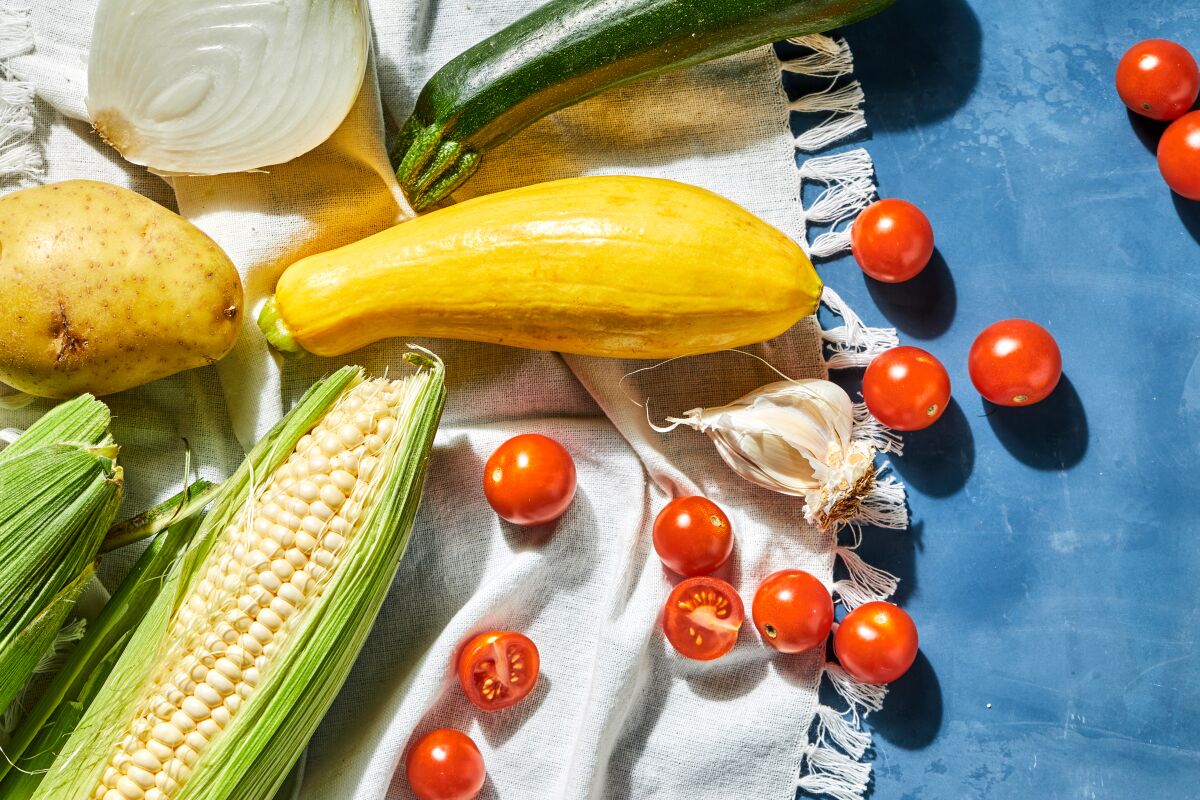Last summer, I drove through the South of France during “la canicule,” or the extreme heatwave that blanketed Europe for weeks. My partner and I started in Cassis and made our way west, stopping in Toulouse for a night, then on to an old French farm home outside of Bergerac, a town about an hour and a half east of Bordeaux, where two friends had just moved. We embraced life sans air conditioning all weekend because, well, we had to.
All of our meals were cold or room temperature or we ate out, so as to not add any heat to the kitchen. But one afternoon, I wanted to cook for our hosts, so we went shopping at the market that day for ingredients. All of the tomatoes, zucchini, potatoes and eggplants were at their best, and I wanted to make a dish that reflected the best summer produce cooked simply but elegantly. To me, that meant tian.

Summer in California means the makings of a tian, the Provençal dish that layers squash, tomatoes, onion and potato.
(Katrina Frederick / For The Times)
A tian is that classic Provençal dish that layers many thin slices of squash, potato and tomatoes with onions and herbs, baked until bubbly and tender. It’s a recipe I’ve always loved making and while in France, at the apex of summer, it seemed only fitting to break it out while we were going to be sweaty in the kitchen no matter what we made. And what’s great about the dish is that you don’t really need a recipe, since the amount of vegetables you’ll use depends on the size of your cooking vessel and how many layers you want.
Many recipes call for layering onions or shallots in with the vegetables, but I wanted them to be cooked down so I could use more of them, so I started off slowly cooking some onions in a pot until they were translucent and just beginning to brown. After scraping them out to cool, I then laid out a layer of thinly sliced potatoes in the bottom of a dish. The potatoes take the longest to cook and protect the rest of the vegetables from burning too soon, but the best reason they go in first is so they can crisp up into a foundation of golden brown crunchy potatoes.
Layer thinly sliced vegetables in a dish, taking sips of chilled rosé as you work.
(Katrina Frederick / For The Times)
After the potatoes, I spread some of the cooked onions over the top, followed by some zucchini, and then repeated the layering until the vegetables just about reached the top of the shallow skillet. I layered some sliced tomatoes over that and then tore some stale bread into the tiniest pieces I could manage with my wine-fueled lack of patience. Into the oven it went, where it baked up tender and umami-rich, like a meaty casserole flavored with just the reduced essence of the summer vegetables. Beads of condensation dripped down our glasses of rosé, and we ate the tian lazily, spooning off bits and pieces from around the table until every last crunchy bit was gone.
Back in the U.S. for this summer, I wanted to re-create that same effortless summer feeling with my own spin on the tian. Yes, there’s a little bit of slicing involved, but otherwise, the slow, methodical layering — and taking sips of wine in between covering the pot to let each layer of vegetables steam through — is the point of it being such an “easy” dish.
The top layer of this American-summer version of tian is ripe red tomatoes.
(Katrina Frederick / For The Times)
To my tian, I added a serrano chile and some grated fresh corn kernels to the onions, which give it both spice and sweetness and an unmistakable American summer quality. Halved cherry tomatoes — Sungolds, if you can get them — go on top to make finishing the dish that much easier.
Once it comes out of the oven, you can kill the heat and let the tian set up and cool for hours. That’s another part of its charm: It’s a dish that shines at room temperature. The vegetables have time to exhale their warmth and collapse and settle into a soft but sturdy stack. In similar fashion, on that hot French summer day, we slumped into our chairs after a sweaty time in the kitchen, clinked a few more ice cubes into the rosé and tucked into the cooled vegetable casserole, letting it — and the cool night breeze blowing across the dining room — cool us down after a long, hot day.
Stay connected with us on social media platform for instant update click here to join our Twitter, & Facebook
We are now on Telegram. Click here to join our channel (@TechiUpdate) and stay updated with the latest Technology headlines.
For all the latest Food and Drinks News Click Here

